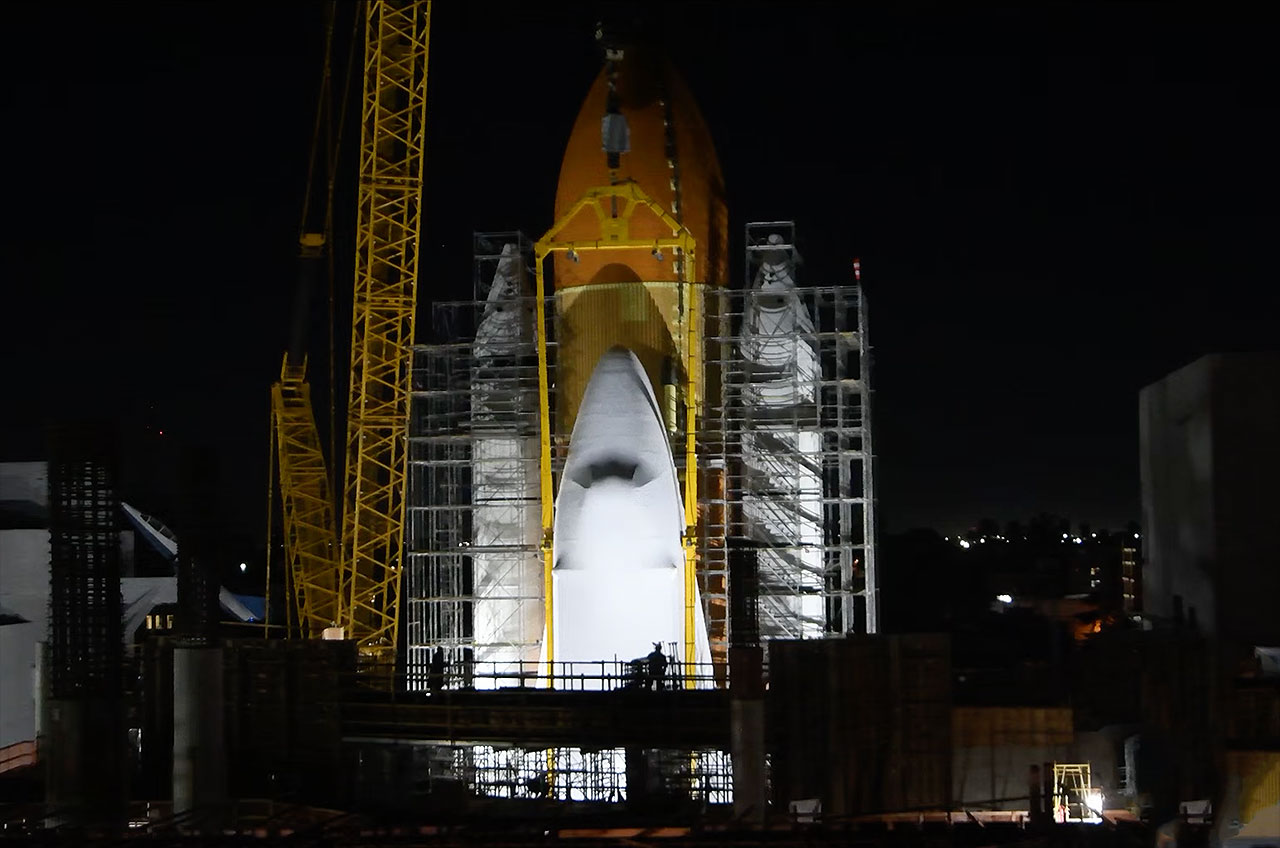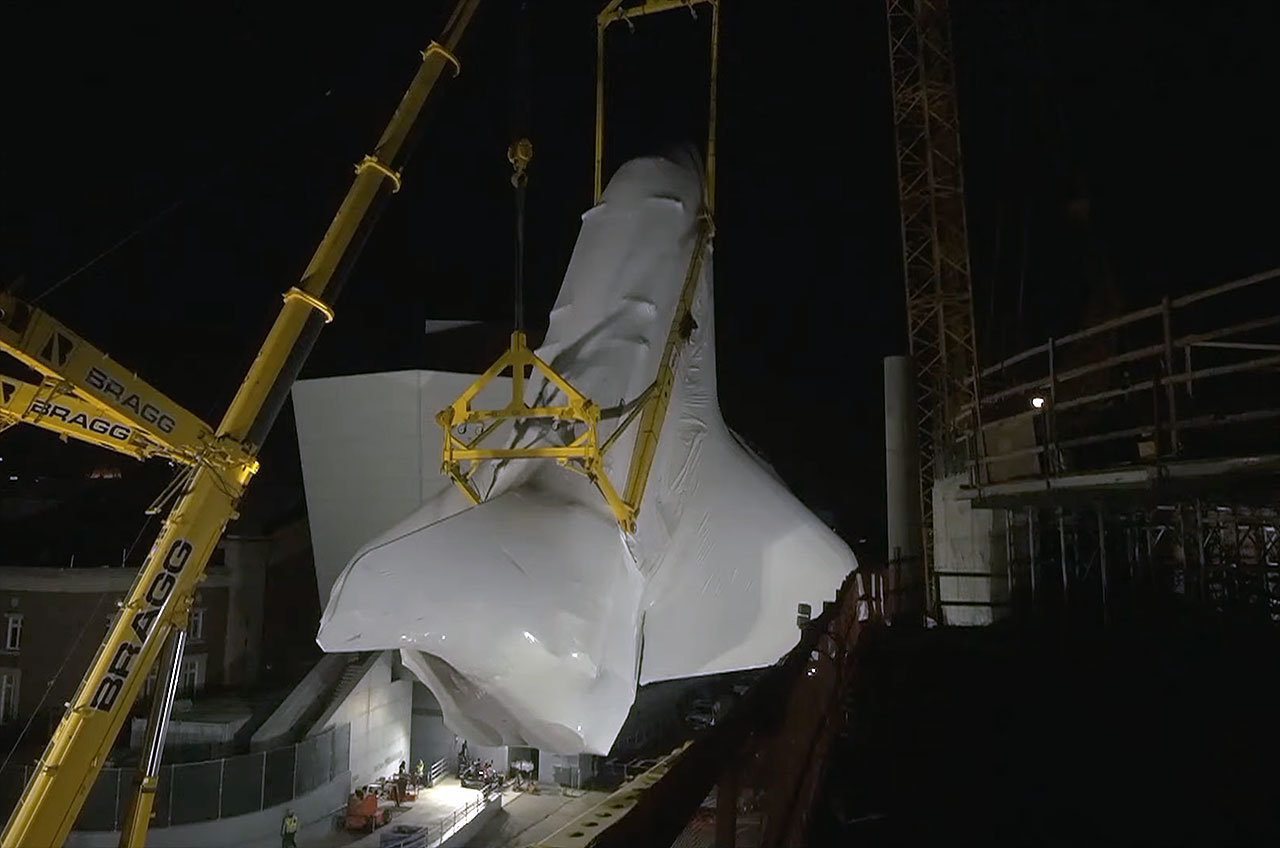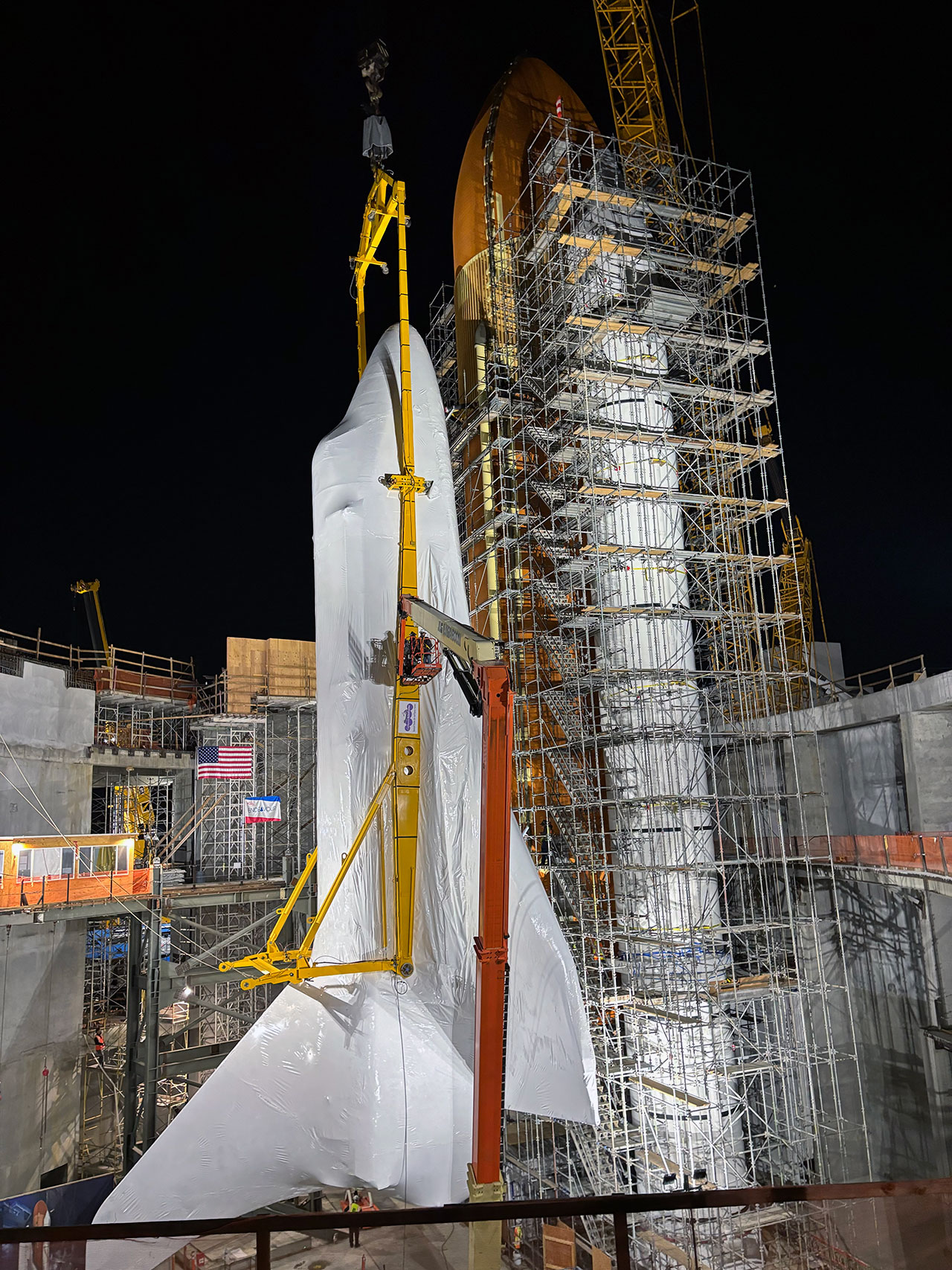Endeavour lifted onto space shuttle stack for California Science Center exhibit (video)
'I think we all feel a huge sigh of relief knowing that the hardest part of this whole project and the thing that's never been done before on a site like this is now behind us.'
A complete space shuttle is standing upright for the first time in more than a decade.
Overnight Monday into the early hours of Tuesday (Jan. 29-30), two large cranes carefully lifted NASA's retired winged orbiter Endeavour off a Los Angeles side street into the air and then lowered it onto an already-standing external tank with twin solid rocket boosters.
The stacking process, which was commonly done to prepare for launches when the space shuttle program was active, was carried out this last time to erect Endeavour's display in the still under construction Samuel Oschin Air and Space Center at the California Science Center.
"It is just so exciting to have actually completed this and to see a 30-year dream fulfilled," said Jeffrey Rudolph, president and chief executive officer of the California Science Center, in an interview with collectSPACE.com. "I think we all feel a huge sigh of relief knowing that the hardest part of this whole project and the thing that's never been done before on a site like this is now behind us."
Related: Endeavour: NASA's Youngest Shuttle

First proposed by the science center staff as an a pie-in-the-sky exhibit back in the 1990s, the path to erecting a space shuttle in Exposition Park began becoming a reality with NASA's decision to award Endeavour to the science center for display. For the past 12 years, the iconic spacecraft had been exhibited raised off the floor on its wheels, but from the start the plan was to permanently showcase Endeavour in its vertical, launch-like configuration.
To achieve that goal, the science center not only had to source NASA's last built-for-flight external tank (bringing it L.A. by way of the Panama Canal) and obtain two flight-proven solid rocket boosters from Northrop Grumman, but also raise the estimated $400 million needed for Endeavour's new home, a reality made possible by a long list of donors led by the Mr. and Mrs. Samuel Oschin Family Foundation.
Under the oversight of Dennis Jenkins, a veteran of NASA's shuttle program, together with a team of his former colleagues, the science center's "Go for Stack" effort erected the two solid rocket boosters in a series of three lifts in July, November and December 2023. The external tank followed earlier this month.
After covering Endeavour in shrink wrap to protect its thermal blankets and tiles from being stained by the dust and dirt kicked up in a typical work site and moving it out of its display pavilion, the orbiter was driven the short distance to beside its future home on Friday (Jan. 26). There, the same yellow sling that was used to lift Endeavour in NASA's Vehicle Assembly Building (VAB) in Florida was attached to the vehicle one last time.

Endeavour left the ground at around 9:30 p.m. PDT on Monday (12:30 a.m. EDT or 0530 GMT on Tuesday) as two cranes slowly raised the 122-foot-long (37-meter) spacecraft off of its transporter. The orbiter was then slowly swung into the vertical and then a 450-foot (137-meter) crane lifted Endeavour up and over the partially constructed walls of the Oschin Air and Space Center.
Just under nine and a half hours later, Endeavour was "soft mated" to the upper and lower attach points on the external tank. That will be followed on Tuesday night by a hard mate, when the bolts and nuts will be completely torqued, firmly securing the orbiter in place.
The sling and crane will then be detached, marking an end to "Go for Stack." There is still much to be done, though, before Endeavour can return to public display.
"We still have a lot of work to do," said Rudolph. "We have to get through the major erection of structural steel above the shuttle. That's the most complex part of the structure."
"We are building a space 200 feet tall [61 meters] with no columns and no walls in it, except for the perimeter supporting the whole thing," he said.

To protect against the chance of debris falling onto the vehicle from above, before construction of the building resumes, a steel plate shell will be erected over Endeavour using the scaffolding that was built around the tank and boosters as a support skeleton.
Construction is then expected to continue for the next 18 months, before outfitting will begin.
"We have about 100 other spacecraft and aircraft to put into the building, all much easier than Endeavour and the space shuttle stack, but not simple," said Rudolph. "Then we have a bunch of exhibits to install, so there is a lot of work ahead of us."
In addition to configuring all of the other displays, Jenkins and his team will need to bring down all of the scaffolding, unwrap Endeavour and then open one of the orbiter's 60-foot-long [183-meter] payload bay doors. A 20-story-tall viewing gantry that will stand beside the space shuttle will give visitors a chance to look inside the orbiter's cargo hold, where a flown Spacehab module is installed.
An opening date has yet to be set, but Rudolph expects that the Samuel Oschin Air and Space Center and its Endeavour exhibit will be ready to debut in the next several years.
Click through to collectSPACE to see more photos from the California Science Center's "Go for Stack" space shuttle Endeavour lift and mate.
Follow collectSPACE.com on Facebook and on Twitter at @collectSPACE. Copyright 2024 collectSPACE.com. All rights reserved.
Get the Space.com Newsletter
Breaking space news, the latest updates on rocket launches, skywatching events and more!
Join our Space Forums to keep talking space on the latest missions, night sky and more! And if you have a news tip, correction or comment, let us know at: community@space.com.

Robert Pearlman is a space historian, journalist and the founder and editor of collectSPACE.com, a daily news publication and community devoted to space history with a particular focus on how and where space exploration intersects with pop culture. Pearlman is also a contributing writer for Space.com and co-author of "Space Stations: The Art, Science, and Reality of Working in Space” published by Smithsonian Books in 2018.In 2009, he was inducted into the U.S. Space Camp Hall of Fame in Huntsville, Alabama. In 2021, he was honored by the American Astronautical Society with the Ordway Award for Sustained Excellence in Spaceflight History. In 2023, the National Space Club Florida Committee recognized Pearlman with the Kolcum News and Communications Award for excellence in telling the space story along the Space Coast and throughout the world.










